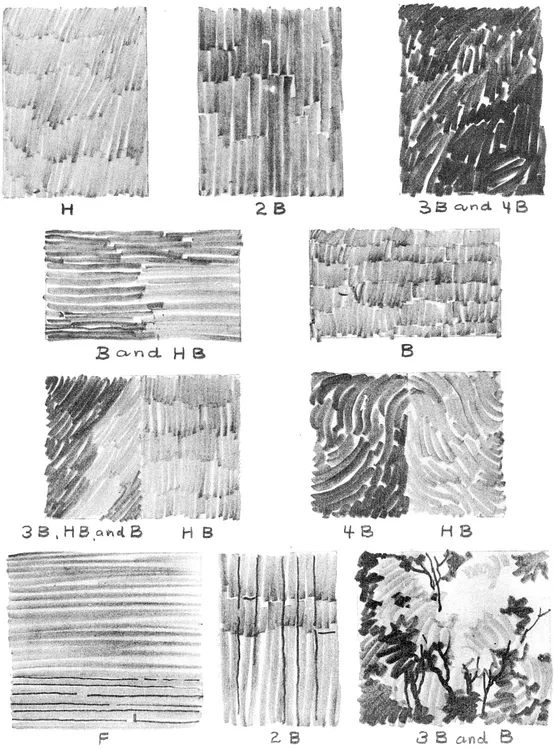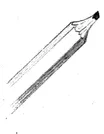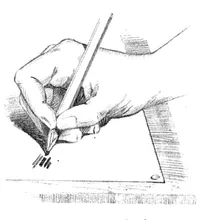
- 64 pages
- English
- ePUB (mobile friendly)
- Available on iOS & Android
eBook - ePub
Landscape Drawing in Pencil
About this book
Concise and beautifully illustrated, this guide provides invaluable instruction on the art of pencil drawing. It covers the basics of holding the pencil, applying different strokes, shading, perspective, and the rendering of different textures, as well as the finer points of pictorial composition and drawing from nature.
Based on the author's years of experience teaching art students at all levels, this book is ideal for home or class use. Its thirty-six evocative sketches range from English castles to American bridges, with a few detailed close-ups showing how to surmount some of the problems of depicting rocks, roofs, standing water, or leafy tree branches. The accompanying text describes how artists at every level of experience can develop their own pencil technique by employing fundamental rules.
Based on the author's years of experience teaching art students at all levels, this book is ideal for home or class use. Its thirty-six evocative sketches range from English castles to American bridges, with a few detailed close-ups showing how to surmount some of the problems of depicting rocks, roofs, standing water, or leafy tree branches. The accompanying text describes how artists at every level of experience can develop their own pencil technique by employing fundamental rules.
Frequently asked questions
Yes, you can cancel anytime from the Subscription tab in your account settings on the Perlego website. Your subscription will stay active until the end of your current billing period. Learn how to cancel your subscription.
At the moment all of our mobile-responsive ePub books are available to download via the app. Most of our PDFs are also available to download and we're working on making the final remaining ones downloadable now. Learn more here.
Perlego offers two plans: Essential and Complete
- Essential is ideal for learners and professionals who enjoy exploring a wide range of subjects. Access the Essential Library with 800,000+ trusted titles and best-sellers across business, personal growth, and the humanities. Includes unlimited reading time and Standard Read Aloud voice.
- Complete: Perfect for advanced learners and researchers needing full, unrestricted access. Unlock 1.4M+ books across hundreds of subjects, including academic and specialized titles. The Complete Plan also includes advanced features like Premium Read Aloud and Research Assistant.
We are an online textbook subscription service, where you can get access to an entire online library for less than the price of a single book per month. With over 1 million books across 1000+ topics, we’ve got you covered! Learn more here.
Look out for the read-aloud symbol on your next book to see if you can listen to it. The read-aloud tool reads text aloud for you, highlighting the text as it is being read. You can pause it, speed it up and slow it down. Learn more here.
Yes! You can use the Perlego app on both iOS or Android devices to read anytime, anywhere — even offline. Perfect for commutes or when you’re on the go.
Please note we cannot support devices running on iOS 13 and Android 7 or earlier. Learn more about using the app.
Please note we cannot support devices running on iOS 13 and Android 7 or earlier. Learn more about using the app.
Yes, you can access Landscape Drawing in Pencil by Frank M. Rines in PDF and/or ePUB format, as well as other popular books in Art & Art General. We have over one million books available in our catalogue for you to explore.
Information
DRAWING IN LEAD PENCIL
There are four important things to work for when drawing with the pencil. The first is correct drawing, the second, design, or composition. Of course, these are needed for successful results in any medium. The third; to be able to leave out all unimportant detail, and the fourth; to obtain contrast, sparkle, and “snap,” are the goals for which the embryo pencil artist must strive. The eliminating of all that is not pertinent to the subject, is a stumbling block which retards the progress of every beginner, nevertheless it is an important element of all artwork; for, in spite of the variety of tones which the different grades of drawing pencils will produce, simplicity, so needful in bringing about contrast, prohibits the introduction of any but the essential or dominant features of the subject.
Merely reading this statement will not, perhaps, impress the student; but the fallacy of drawing everything he sees will gradually come to him as he progresses with his work. Therefore, we will dispense with further discussion of the matter at this time, but will bring it forward frequently, clothed in slightly different terms.
Technique is the outstanding point of pencil sketching which makes it so different in character from other media. The way the strokes are made is one of the most potent ways of making the drawing interesting. While the technique, when the sketch is completed, should not be so obvious as to blind the observer to the other qualities, yet the way the strokes are laid on is what constitutes the charm of a pencil sketch. The way in which the drawing is done, or built up, is one of the reasons for using the pencil in the beginning.
As stated in the introduction, it is presupposed that the reader has some knowledge and understanding of the principles of drawing and perspective, but that making finished sketches with the pencil is more or less new to him. Therefore, a certain familiarity with his materials and how to use them, is the logical first step. With this in mind, the following sketches and diagrams have been prepared. A conscientious study of these will bring home many facts, which mere words would fail to do.
It has been said that “a good workman never complains of his tools.” Very true; but have you ever noticed that a good workman never needs to complain; that he always has good tools?
One of the most important things with which to start, is a drawing board, unless one intends to do all his work indoors, in which case a drawing or drafting table will do. In any event the wooden surfaee should not measure less than 14 x 20 inches. The reason for this will appear later. For paper, a smooth surface white Bristol Board of not less than three ply is necessary. This paper, which comes in a sheet 22 x 28 inches in size, may very conveniently be divided into four pieces of 11 x 14 inches each. There are several reasons for emphasizing this particular paper so strongly, one of which is its erasing qualities; no matter how much it is scrubbed, the surface is never impaired. Another equally important reason is its sympathetic response to every pencil stroke; while later on when the student has acquired considerable efficiency in rendering, he may experiment with other papers, it is predicted that he will never become fully weaned from the Bristol Board, when, by actual test, its value has been proven. All the drawings shown here were made on this paper, on the quarter sheets. The fact that they have been reduced to their present size should be borne in mind when examining the strokes.


The better makes of drawing pencils, of which there are several, come in a series of grades of hardness and softness. They range from 8 H, the hardest, to 6 B, the softest. For our purposes the 2 H, H, F, HB, B, BB, BBB, and BBBB are all that are necessary, but none of these grades should be omitted.
Besides pencils, paper, and board, three kinds of erasers are required; a kneaded, a medium hard, and a piece of Art gum. Something on which to wear down the points of the pencils, after they have been sharpened with either a sharp knife, or a razor blade; a piece of sandpaper, or better still, a “charcoal scratcher,” as they are called, and a few thumbtacks complete the equipment and the student is ready to take the first plunge.
This first plunge, and many following it, should consist of practising the different strokes, in order to become thoroughly familiar with the “feel” of the pencil and to get acquainted with its possibilities. Prior to this, however, the pencils should all be cut as shown. Not more than 3/16 of an inch of the lead should project beyond the wood, but this lead should be left its full diameter, and not tapered. When all the pencils have been cut this way they should be held at an angle of about 45 degrees, and, on the sandpaper, worn to a wedge shape, as shown in the illustration. Before attempting to draw with them, run them over a piece of scrap paper once or twice, in order to remove all loose graphite. When this has been done, by holding the pencil as shown in sketch of hand, either the widest of lines (dependent upon the thickness of the lead) can be made, or also, the finest of lines, by turning the pencil so that only the edge touches the paper.

Of all the pencils mentioned, the 2H alone should be cut to a sharp point instead of the wedge shape, and used to lightly sketch in the outline and shadow shapes of the drawing. If these lines are drawn lightly enough, they need not be erased; it is always better to lay in the construction lines lightly.


As a careful examination of the strokes will reveal, they have in all cases been made direct, that is, each stroke has been made in some definite direction, and then left that way; it has not been scumbled, or gone over again. In many cases, each stroke is distinctly separated from the others with a streak of white paper between; again, they have been placed so closely together that they give the appearance of a flat wash, or as if done with a brush. In any event the strokes must be made with decision; that is why plenty of time should be spent on just the practice...
Table of contents
- Title Page
- Bibliographical Note
- Copyright Page
- INTRODUCTION
- Table of Contents
- DRAWING IN LEAD PENCIL
- BATH PLACE, OXFORD
- PUNTING ON THE CHERWELL
- LANE IN WOODSTOCK
- COVERED BRIDGE, VERMONT
- OVER THE RIVER
- FISHER ROW AND OXFORD CASTLE
- BRIDGE AT GODSTOW
- RUINS OF AN OLD NUNNERY
- THE OLD AND THE NEW
- OLD MILL IN LONDONDERRY, VERMONT
- THATCHED COTTAGE, GARSINGTON
- WEST RIVER, VERMONT
- GRANGE GATE, MILTON, ENGLAND
- THE WILLOWS
- OLD CHASE HOMESTEAD
- OLIVER CROMWELL’S MILL
- A CHIDDINGSTONE COTTAGE
- COTTAGE AT CLIFTON HAMPDEN
- HALF TIMBERED HOUSES IN KENT
- MAGDALEN TOWER, OXFORD
- MAGDALEN TOWER FROM THE MEADOW
- THE FISH WHARVES, ROCKPORT